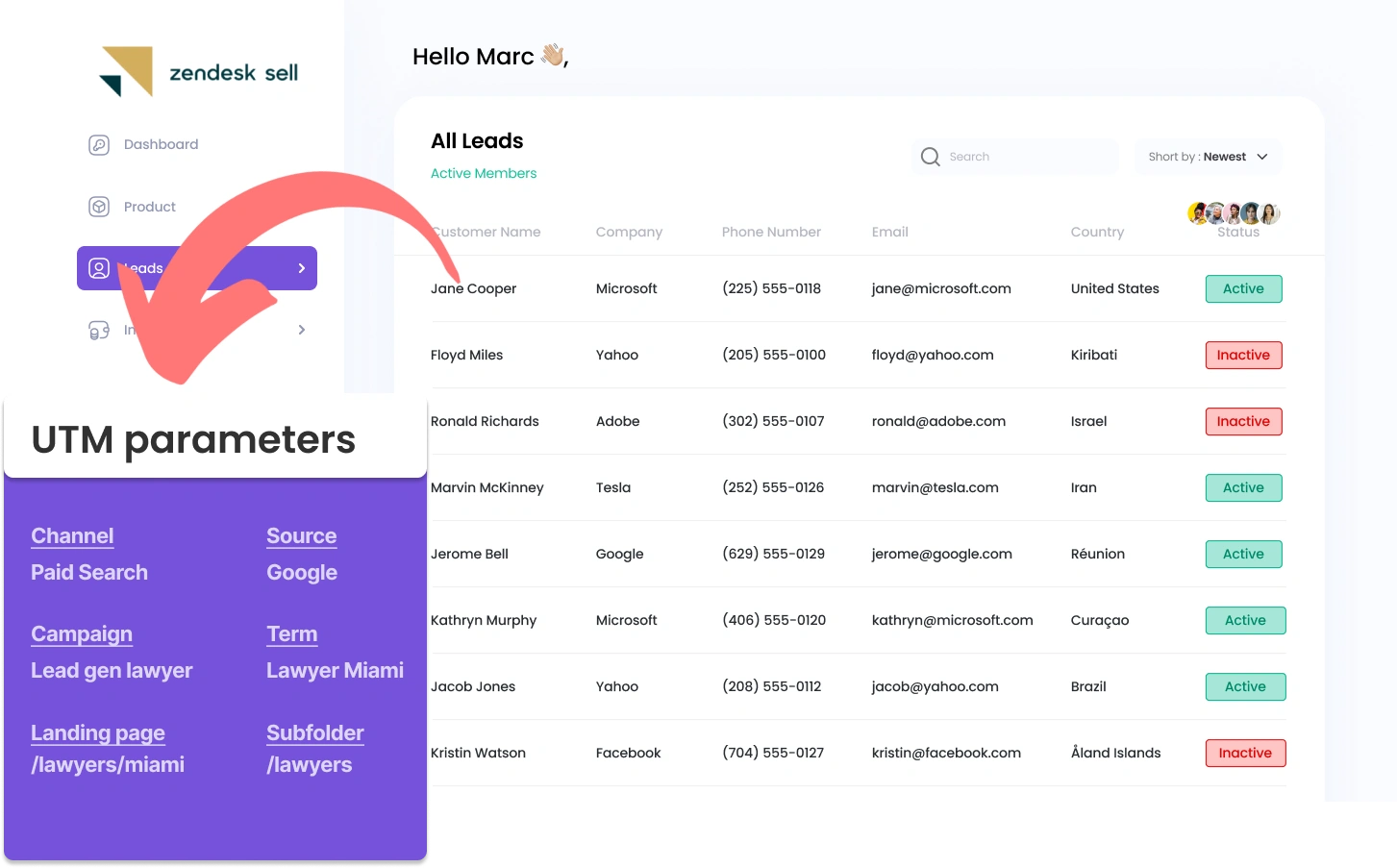Incorporating UTM parameters into Zendesk Sell can be complicated, especially for users without coding knowledge.
What if integrating UTM parameters into Zendesk Sell could be done easily, with zero coding involved?
Meet Leadsources.io!
Leadsources is a lead source tracking tool that acts as a middleman between your UTM parameters and your CRM (in this case, Zendesk Sell).
When a visitor engages with your marketing campaign, Leadsources automatically extracts the UTM parameters from the URL and fills them into your form’s hidden fields.
By linking your form to Zendesk Sell, you can view new leads along with their UTM parameters right in Zendesk Sell.
This setup lets you generate performance reports and identify the sources of your most valuable customers.
In this guide, you’ll learn how to set up UTM parameter tracking in Zendesk Sell in just 10 minutes using Leadsources, without any coding.
Capture UTM parameters into Zendesk Sell in 4 easy steps
Step 1: Add Leadsources in the head tag of your website
Sign up to Leadsources.io, and benefit from our 14-day free trial.
Add the Leadsources code in your website’s head tag, and no need to know coding.
Simply follow the step-by-step guide we have created.
Step 2: Add the UTM parameters to your campaigns
Specify the UTM parameters you plan to track in your campaigns (PPC, email, social media, etc.).
Leadsources is compatible with these UTM parameters:
- UTM_source
- UTM_campaign
- UTM_term
- UTM_content
Leadsources includes information beyond UTM parameters, such as the channel, landing page, and landing page subfolder.
Step 3: Add the hidden fields to your form
When visitors complete your form (name, email, etc.), Leadsources automatically fills in the hidden fields with UTM parameters (channel, source, etc.).
To do this, add hidden fields to your form for UTM parameters. We’ve prepared a step-by-step guide for every form builder.
Step 4: Track the UTM parameters into Zendesk Sell
When individuals click on your campaign and land on your website, Leadsources captures the UTM parameters from the URL.
The UTM parameters are inserted by Leadsources into the hidden fields of your form.
After a form is submitted, the UTM parameters and the responses are sent to Zendesk Sell. Connecting your form to Zendesk Sell is required for this process.
How does Leadsources work?
By incorporating the Leadsources code into the head tag of your website, UTM parameters in the URL are captured by Leadsources each time someone lands on your site.
It then stores the UTM parameters in the hidden fields of your form.
Leadsources can still gather information about a visitor who comes to your site without UTM parameters by using the referrer:
- Channel
- Source
- Campaign
- Landing page
- Landing page subfolder
In that way, essential lead source data can be tracked even if UTM parameters are not used, including:
- On Google Search
- On your Instagram bio link
- On your social media posts
While UTM parameters are often required for tracking lead sources with other tools, Leadsources offers tracking regardless of where leads originate:
- Organic Search
- Paid Search
- Organic Social
- Paid Social
- Referral
- Affiliate
- Display Advertising
- Direct Traffic
This creates a process of collecting and storing lead source data in one place.
How to run performance reports
Now that you have captured your UTM parameters into Zendesk Sell, you can use it to run performance reports such as:
- Leads per channel
- Revenue per channel
- Revenue per keyword
This allows you to make informed decisions about your marketing spend.
Let’s assess the various report types you can run.
Lead performance reports
You can run reports showing the volume of leads generated by:
- Channel
- Source
- Campaign
- Landing page
- Landing page subfolder
Example #1
If your campaigns are spread across various channels (SEO, PPC, email, etc.), you can extract the data and create a report named: “Leads by Channel.”
Example #2
After finding out which channel delivers the most leads (e.g., Google Ads), you can drill down by selecting this channel and analyzing the lead volumes from each of your ad campaigns.
Example #3
Once you identify the top-performing campaign for lead generation, you can explore the specific keywords that are driving those leads.
Sales performance report
Understanding which ads and keywords result in the most leads is key, but do they also contribute to your overall revenue?
When you send form submissions to Zendesk Sell, it facilitates the generation of in depth sales performance reports.
Example:
| Channels | Search Paid | Social Paid |
| Leads | 50 | 75 |
| Sales | 5 | 6 |
| Average order value | $150 | $100 |
| Revenue | $750 | $600 |
You ran ads on Google and Facebook. Data from your Google and Facebook ads indicated that Social Paid ads outperformed Search Paid ads in terms of lead generation.
After a few weeks of analysis, it was evident that the Search Paid channel, although it had fewer leads, generated more revenue than Social Paid. This helps you decide to raise your Search Paid budget.
LeadSources tracks the source of each lead in Zendesk Sell, whether they come from ads, organic search, social, email, etc. and syncs that data with each submission. See the full breakdown on the lead source in Zendesk Sell page.
